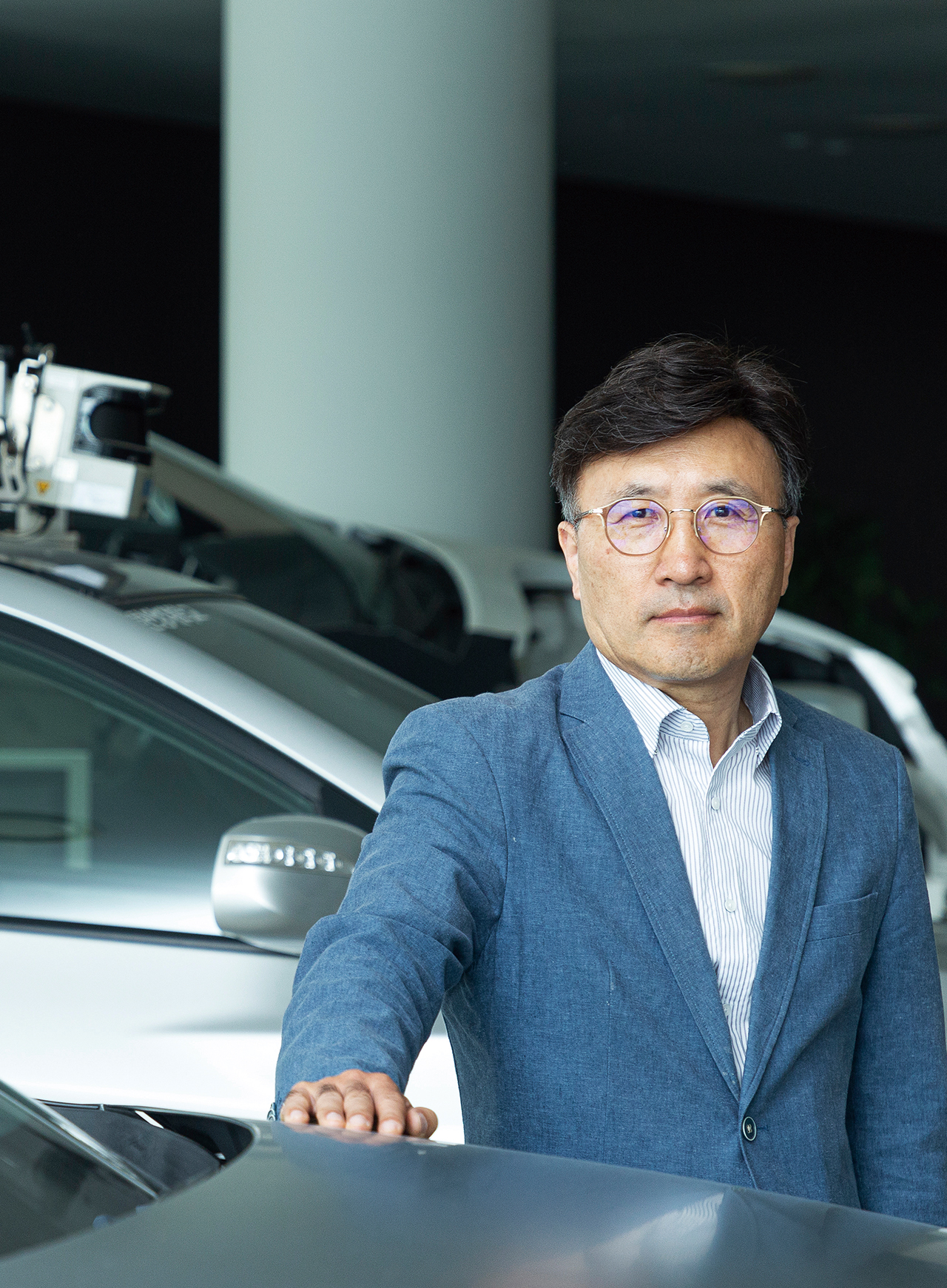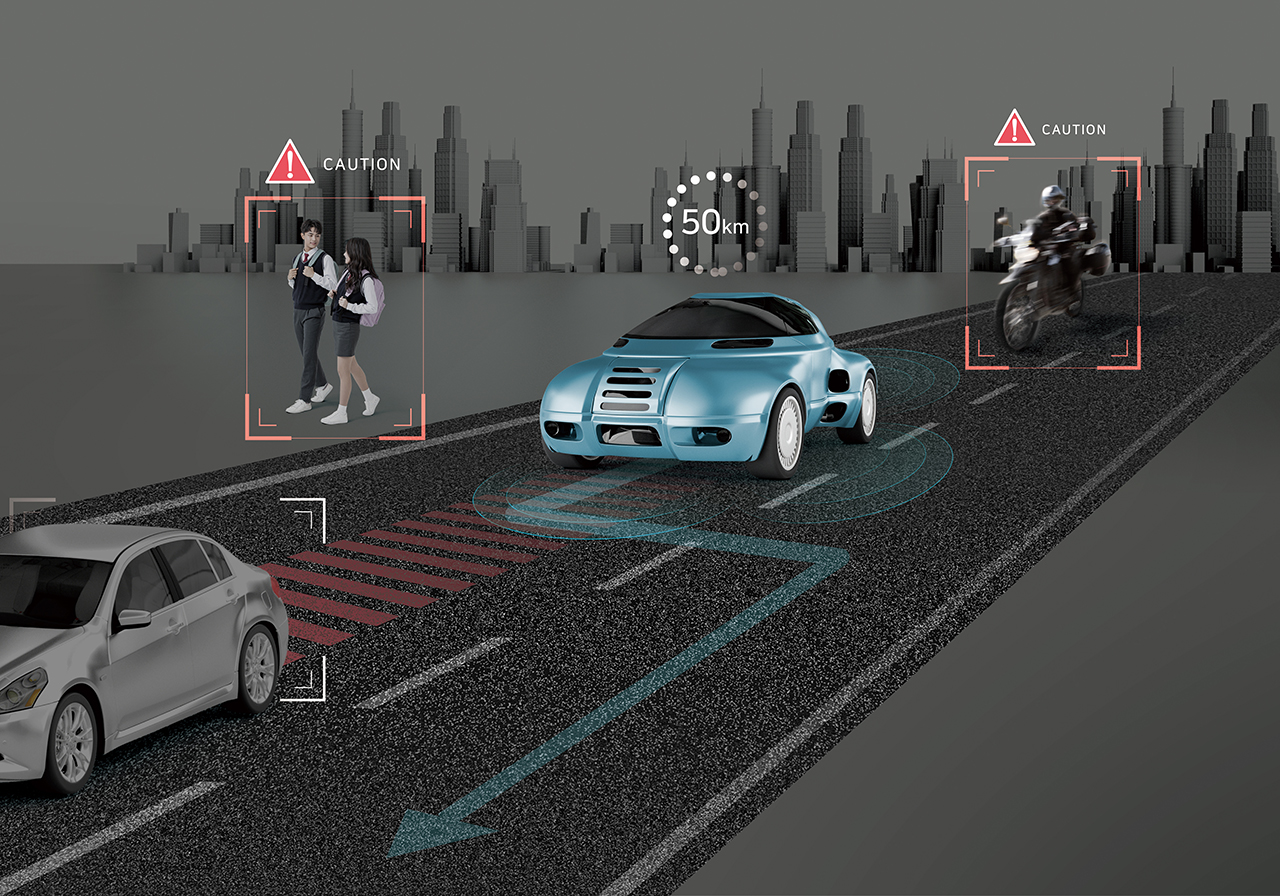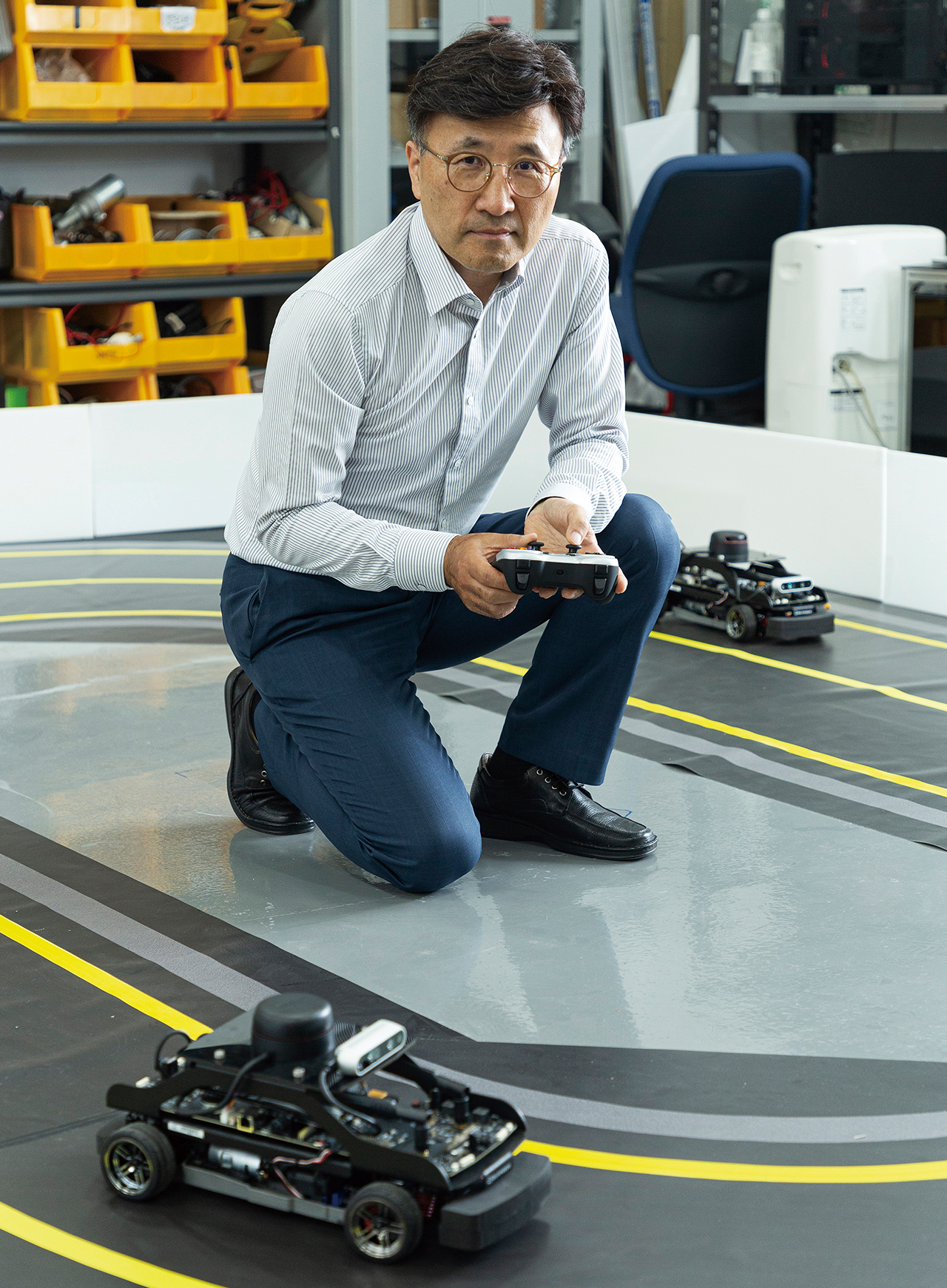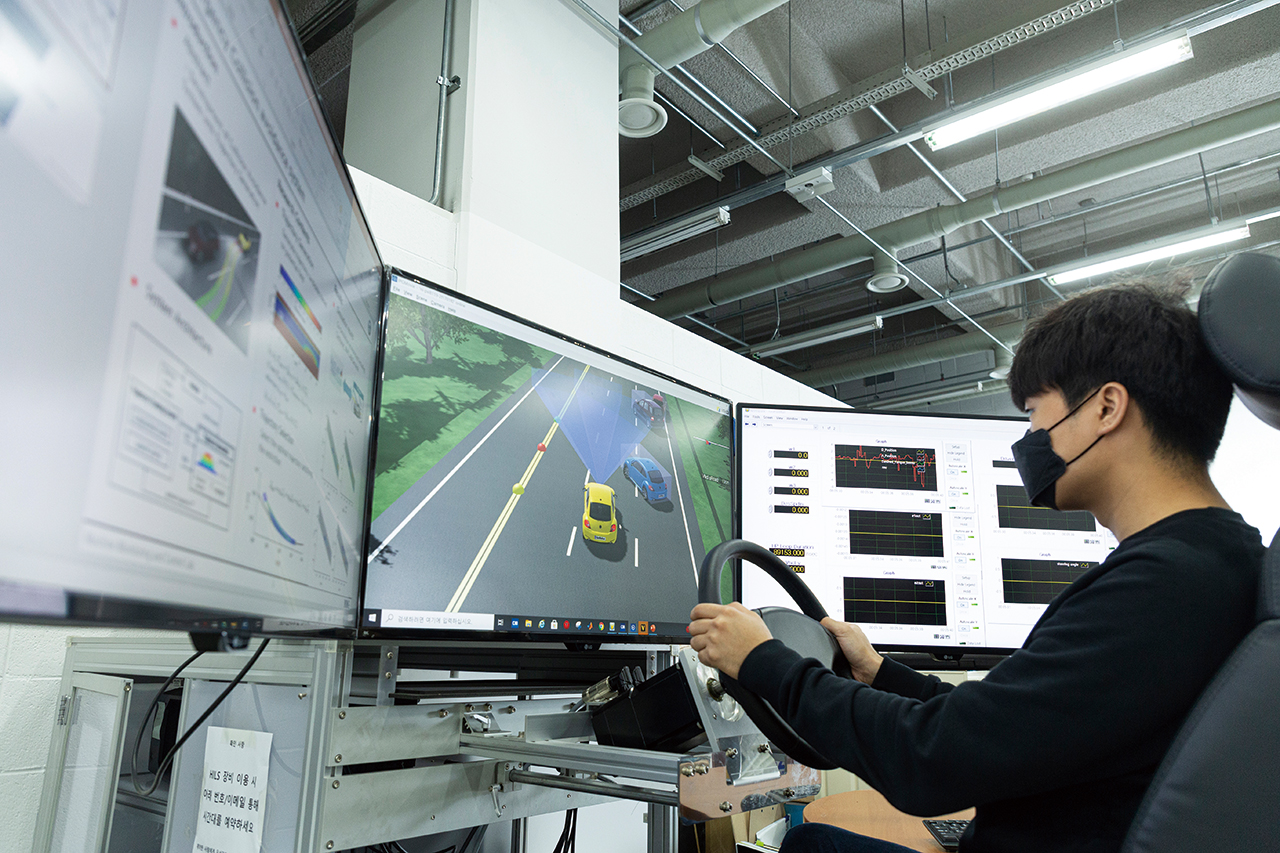Contents VOL. 258

COVER STORY
<HYPER> 여름호는 자율주행 차와 친환경차로 대변되는 이동 수단의 혁명, 모빌리티의 미래를 테마로 다뤘습니다. 이번호 기사를 통해 생각해보세요. 빠르게 발전하는 첨단과학 기술들, 그 변화의 흐름을 따르기만 하면 우리는 과연 멋진 신세 계에 도달할 수 있을까요?

<HYPER> 여름호는 자율주행 차와 친환경차로 대변되는 이동 수단의 혁명, 모빌리티의 미래를 테마로 다뤘습니다. 이번호 기사를 통해 생각해보세요. 빠르게 발전하는 첨단과학 기술들, 그 변화의 흐름을 따르기만 하면 우리는 과연 멋진 신세 계에 도달할 수 있을까요?
Scroll Down
Autonomous vehicles, which drive by themselves without human control, are the combination of the latest technology and a keyword for future technology. The complete autonomous driving of finding paths while driving, adjusting operation according to traffic signals, avoiding obstacles, and changing directions, all without human intervention. When will this become a reality?

미래자동차공학과 허건수 교수
Professor Heo Keon-su, Department of Automotive Engineering
“자율주행 기술은 레벨-1부터 레벨-5까지 다섯 단계로 나뉘는데, 그 정의는 미국·유럽·아시아에서 공통으로 사용됩니다. 당연히 단계가 올라갈수록 훨씬 고도화된 자율주행 기술이 요구됩니다.”
한양대학교 미래자동차공학과 허건수 교수의 설명에 의하면, 1단계 자율주행 기술은 속도를 유지해주는 순항제어 또는 차선이탈방지 등의 선택적 능동제어로 이미 많이 상용화되어 있다. 2단계 자율주행 기술은 통합 능동제어에 해당한다. 고속도로나 자동차전용도로에 들어서면 운전자가 지정한 속도로 자동으로 운행하다가 전방 차량이 서행할 경우 일정 거리를 유지하도록 가속 및 감속을 제어하는 수준이다. 동시에 차선의 형태에 따라 자동으로 핸들을 돌려서 차선을 쫓아가는 기능을 수행한다. 최근 3~4년간 테슬라, GM, 메르세데스 벤츠, 현대기아자동차, BMW, 아우디, 포드, 폭스바겐 등 많은 자동차회사에서 레벨-2 자율주행 기능을 장착한 차량을 활발히 판매하고 있다. 자율주행 기술로 널리 알려진 테슬라의 오토파일럿(Auto Pilot)도 실제로는 2단계의 통합 능동제어에 해당한다.
“3단계는 부분적인 자율주행으로, 아직까지 어디에서도 상용화가 이뤄지지 않았습니다. 자율주행이 가능하지만, 필요시 운전자에게 운전을 요청할 수 있는 수준입니다. 예를 들어, 전방에 갑작스러운 사고나 도로공사로 자율주행이 어려운 경우 운전자가 요청을 받고 대신 운전하는 것이죠. 4단계는 부분적·제한적인 자율주행으로 목적지를 입력했을 때 고속도로를 이용해서 톨게이트까지 자동으로 갈 수 있는 수준이고, 5단계에 이르면 비로소 출발지에서 목적지까지 알아서 가는 완전 자율주행이 실현됩니다.”
“Autonomous driving technology is composed of five steps from level-1 to level-5, which is a definition used commonly throughout the United States, Europe, and Asia. Of course, the higher the stages, the more advanced autonomous driving technologies are required.”
According to the explanation of professor Heo Keon-su from the Hanyang University’s Department of Automotive Engineering, the level-1 autonomous driving technology has already been commercialized through vehicle cruise-control for steady speed and selective active control technology in preventing lane departures. The level-2 autonomous driving technology corresponds to comprehensive active control. This means that the level of control of the acceleration and the braking to maintain a certain distance is set by the driver, and when the vehicle in front slows down, it automatically decelerates or accelerates to maintain a certain distance. It also includes following the lane by shifting the handle according to the lane’s form. During the last 3~4 years, many automobile companies such as Tesla, GM, Mercedes Benz, Hyundai KIA Motors, BMW, Audi, Ford, and Volkswagen have been actively selling automobiles with level-2 autonomous driving functions. In fact, Tesla’s AutoPilot, which was widely recognized with its autonomous driving technology, falls under the level-2 comprehensive active control.
“Level-3 is a partial autonomous driving system, which has not been commercialized anywhere yet. Autonomous driving is possible, but the system can also request the driver to manually control the vehicle when necessary. For example, if autonomous driving is difficult from a sudden accident or road renovations, the driver receives a request to drive manually. The level-4 system has the technology to autonomously enter a highway tollgate after setting its destination, while the level-5 system is completely autonomous driving, which can automatically drive from a given starting point to its destination.”
자율주행이 레벨-2에서 레벨-4로 넘어가려면 V2X 통신(차량과 사물 간 통신), 360도 주변 환경인식 센서, 디지털 맵, 측위, 보안, 자율주행 시험평가, 인증 등 수많은 핵심기술이 필요하다. 하지만 아무리 규모가 큰 기술기업, 자동차회사라 할지라도 자율주행에 필요한 모든 기술을 확보하기란 사실상 불가능하다. 최근 5~6년간 자율주행 기술과 관련된 회사 간 합병과 투자, 협력이 끊임없이 이루어지는 이유가 여기 있다.
현재 자율주행 연구와 기술의 선두주자는 미국과 중국이다. 이 두 나라에는 자율주행 관련 핵심기술을 보유한 기업과 스타트업들이 많은 투자를 받고 있으며, 1조 원 이상의 기업가치를 지닌 기업들도 다수 존재한다. 실제로 2020년 자율주행 관련 가장 뛰어난 10대 스타트업 선정에 미국과 중국에서 각각 5개 기업이 선정돼 주목을 받았다.
“우리나라는 자율주행 관련 스타트업이나 관련 기업들의 숫자는 많지 않지만, 보유하고 있는 기술 수준은 높은 편입니다. 특히 자율주행을 위한 주변 환경인식 센서의 경우 사고방지와 편의를 위해 국내 자동차 회사들이 앞다퉈 개발해 상용화했던 ADAS(Advanced Driver Assist System) 영역과 유사해요. 자율주행은 이 영역이 좀 더 확대된 것으로 이해할 수 있습니다. 현대모비스와 만도 같은 글로벌 부품사들이 국내외 자동차회사들에 이미 공급해오던 부품들인데, 센서 기반 제어 기술력으로 보면 독일·일본·미국의 주요 부품사들과 겨룰 만합니다.”
반면, 카메라 비전·레이더·라이더 등 센서 자체의 기술은 뒤처져 있다. 카메라 비전과 라이더 관련 국내 기술은 현저히 부족하고, 그나마 차량용 레이더는 만도와 현대모비스 등이 국산화를 시도하면서 어느 정도 글로벌 경쟁력을 갖췄다. 이처럼 자율주행 기술에 있어 우리나라만의 장점과 차별성을 꼽기는 쉽지 않지만, 작은 영토와 밀집된 교통 환경 그리고 집중화 전략을 잘 이용한다면 상용화 측면에서 유리한 면도 없지 않다.
“레벨-2 자율주행 기술의 상용화는 2015년 테슬라 차량에 오토파일럿이 탑재된 것이 처음입니다. 두 번째가 2016년 현대기아자동차가 탑재한 HDA(Highway Driving Assist) 기능이에요. 사실 레벨-2 자율주행의 기술 개발은 국내 기업이 다른 미국 기업들보다 늦게 시작했지만, 영토가 작고 고속도로의 길이도 60분의 1 정도로 짧아서 전 구간의 시험운행 및 검증을 통한 상용화가 빨라졌습니다.”
미국과 중국 등은 기술 개발이 일찍 끝나도 상용화를 위한 검증이 오래 걸리기 때문에 신기술을 적용하는 데 있어 우리나라가 상대적으로 유리할 수 있다는 뜻이다.
For autonomous driving to move from level-2 to level-4, numerous core technologies are required such as the V2X communication (communication between vehicles and objects), a 360 degree surrounding environment recognition sensor, a digital map, a positioning system, security, autonomous driving evaluation, and certification. However, it is practically impossible to obtain all the necessary technology for autonomous driving, no matter how large a technology company or automobile company is. This is the reason for recent mergers, investments, and cooperation between companies related to autonomous driving technology during the last 5~6 years.
Currently, the leaders in autonomous driving research and technology are the United States and China. In these two countries, businesses and startups holding core technologies in autonomous driving are receiving large investments, and there are many companies worth more than 1 trillion dollars. In fact, 5 companies from the United States and China were selected for the list of the 10 most outstanding startups related to autonomous driving in 2020.
“Korea may not have a large number of startups and businesses related to autonomous driving, but the quality of technologies are rather high. In particular, the surrounding environment recognition sensor for autonomous driving is similar to the ADAS (Advanced Driver Assist System) field, which was competitively commercialized by domestic automobile companies for accident prevention and convenience. Autonomous driving can be understood as the expansion of this area. Global parts manufacturers such as Hyundai Mobis and Mando are some of the companies that have been providing parts to domestic and international automobile companies, and the sensor base control technology is worthy of comparison with German, Japanese, and American major parts manufacturers.”
However, the technology for the sensors, such as camera vision, radar, and rader is lagging behind. Although domestic technology for camera vision and rader is remarkably lacking, some degree of global competitiveness has been achieved thanks to the localization efforts of automobile radars of Hyundai Mobis and Mando. While it is not easy to point out Korea’s own advantages and distinctiveness in autonomous driving technology, it is not without advantages in terms of commercialization if the small territory size, dense traffic environment, and focused strategy are used well.
“The commercialization of level-2 autonomous driving technology first began with Tesla’s installation of the AutoPilot onto their vehicles in 2015. The level-2 autonomous driving technology development started later than other companies in the United States, but commercialization, through test driving and certification, was faster as the territory is small and the length of highways are 1/60 times shorter.”
Even if technology development is completed early in the United States and China, the certification process for commercialization takes a considerable amount of time, which means that Korea may have a comparative advantage in applying new technologies.


미국과 중국에서는 상용트럭·버스·셔틀버스, 로봇택시, 배달로봇 등 공용·상용 목적의 물품 배송, 대중교통과 승객 운송 등을 위한 자율주행 기술 개발, 그리고 이에 따른 투자가 많이 이뤄지고 있다. 미국과 중국의 몇몇 도시에서는 제한적이긴 하지만, 로봇택시와 같은 자율주행 차량이 실제 운행 중이다. 물론 아쉬움이 더 크다. 현재 운행 중인 자율주행 차량은 안전운전자(Safety driver)가 탑승하거나 혹은 부분적으로 운전석을 비워놓고 진행하는 시범운행에 불과하기 때문이다. 자율셔틀도 시니어타운, 공원, 리조트 내 혹은 공항이나 역 주변에서 일정 경로만 저속(40km/h 이하)으로 반복 운행하는 등 아주 제한적이다. 아직은 우리가 꿈꾸는 완전 자율주행과는 거리가 있는 셈이다. 그렇다면 과연 언제쯤 완전한 자율주행 자동차를 만날 수 있을까.
“현재의 기술 수준으로 보면, 운전자 없이 출발지에서 목적지까지 스스로 알아서 가는 완전 자율주행 자동차를 이용하는 것은 먼 미래가 될 것으로 보입니다. 완전한 자율주행 자동차를 만나기 위해서는 기술적으로 넘어야 할 산이 무척 많지요. 자율주행에 들어가는 수많은 기술이 완성돼 레벨-4와 레벨-5가 되는 시점이 언제가 될지 누구도 알 수 없지만 그렇다고 실망할 필요는 없습니다. 지금 개발하는 기술들을 하나씩 고도화해 레벨-2에 적용한다면, 지금보다 훨씬 더 편안하고 안전한 자율주행 자동차를 만나게 될 테니까요.”
자율주행 자동차의 향후 몇 년간 전망은 자율주행 관련 기술 혁신이 얼마나 이루어질지, 그리고 이로 인한 비즈니스모델이 얼마나 단기간에 창출될 것인지에 달려있다. 이와 함께 자율주행 자동차에 대한 제도와 문화, 사고 관련 책임 등 사회적으로 논의하고 합의해야 할 문제들이 쌓여 있는 현실이다. 하지만 그럼에도 모두가 꿈꾸는 완전 자율주행 자동차에 대한 기대와 미래 비전은 여전히 유효하다.
In the United States and China, autonomous driving technology development and investments for product shipment, public transportation, and passenger transport for official use or commercialization is actively carried out through commercial trucks, buses, shuttle buses, robot taxis, and delivery robots. The technology is sometimes limited in several cities in the United States and China, but autonomous vehicles like robot taxis are actually in operation. Of course, there are more regrets. Autonomous vehicles that are currently being operated are mere trial operations with safety drivers on board or partially empty driver seats. The autonomous shuttles are also largely limited to certain places at low speed (under 40km/h) in towns with a large elderly population, parks, inside resorts, airports, and around bus stops. This is still far from the autonomous driving that we’ve been dreaming of. Then, when will we be able to completely see autonomous vehicles?
“Referring to the current technology levels, it seems that using completely autonomous vehicles that go from the starting point to its destination without drivers will happen in the far future. There are still steep technological hurdles to climb in order to one day witness a completely autonomous vehicle. It is impossible for anyone to know when the level of technology will reach levels 4 and 5, but there is no need to be discouraged. If we apply and enhance the technologies being developed to level-2, then we will eventually be able to witness more comfortable as well as safer autonomous vehicles.”
The outlook for autonomous vehicles will all depend on how many technological innovations in autonomous driving take place within the next few years and how fast the resulting business models can be created. Furthermore, there are a multitude of issues that need to be discussed and agreed upon in society regarding policies, the culture, and responsibility for accidents related to autonomous vehicles. Nonetheless, the expectations and future vision for autonomous vehicles that we are all dreaming of is still valid.

비자동화 No Automation
운전자가 모든 조작 제어.
자율주행 기술 없음
The driver controls everything.
There are no autonomous driving technologies.
운전자 보조 Driver Assistance
운전자가 차량의 모든 기능에 대해 선택적 능동 제어.
속도 및 제동 관련 운전 보조기능 탑재
The driver selectively and actively controls all functions of the vehicle.
Auxiliary functions regarding speed and braking are installed.
부분 자동화 Partial Automation
운전자가 차량 기능에 대해 선택적 능동 제어.
시스템이 차 간격 유지, 속도 및 방향 제어
The driver selectively and actively controls vehicle functions.
The system controls the following distance from the car in front, the speed, and the direction.
조건부 자동화 Conditional Automation
운전자가 필요시 운전.
시스템이 교통상황 인식, 차선 변경, 추월, 장애물 감지 및 회피
The driver drives when necessary.
The system recognizes the traffic situation, changes lanes, passes lanes, and recognizes and avoids obstacles.
고도 자동화 High Automation
지정된 조건에서 운전자 없이 주행.
시스템이 주변 환경을 인식해 모든 주행 제어, 비상상황 대처
Drives autonomously without the driver in a set situation.
The system recognizes the surrounding environment, controls all driving operations, and handles emergencies.
완전 자동화 Full Automation
시스템이 모든 조작 제어.
운전자도 운전석도 필요 없는 무인 자동차 단계
The system controls everything.
An unmanned automobile stage without the need for a driver or a driver’s seat